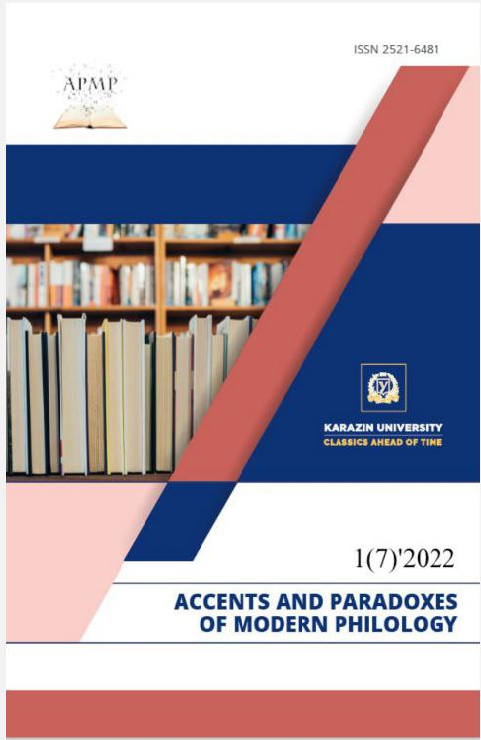TYPES AND FUNCTIONS OF SOUND WRITING IN LYRICAL POEMS BY RAINER MARIA RILKE
Abstract
The article deals with the types and functions of sound in the lyrical poetry of Rainer Maria Rilke. The features of his poetry, dedication to the art of sounding words are emphasized. It
is noted that the types of sound writing and its functions are important for linguistics in Rilke's poetry. The definition of sound writing as a poetic means is given, the difference between the concepts of Lautmalerei and Klangmalerei is clarified. The attention is focused on the fact that Rilke's poetry is characterized by the purity of rhyme, except for unevenly stressed rhymes, which combine a strong ending (with the main emphasis on the last syllable) with a weak one (when the last syllable forms a suffix or another part of the phrase containing only a secondary emphasis). Various criteria by which types of sound writing can be distinguished are outlined. It is noted that according to the criterion of a repeating element in Rilke's poetry, the most important types of sound are presented: assonance, alliteration, internal rhyme and paronomasia. The aesthetic and iconic function of a poetic work is considered. The analysis of the iconic function highlights its three subtypes: suggestive, onomatopoeic and sound semantic. The term "function" is used in the sense of "task". Each of the functions is investigated in the article and illustrated with examples of Rilke's poems. It is found out that the figures of sound in Rilke's poems are characterized by placement in the initial syllable, but can have other positions in the word; vowel length is not taken into account; vowel equivalence is atypical for alliteration; metathesis and uneven consonance are not excluded; both convergence and divergence of phonetic figures occur within the poem, stanza and in the whole text; phonetic figures are tied to syntactic structures. It is emphasized that the creative and effective sound description in the poetry of Rainer Maria Rilke is a significant contribution to the euphony of the text and the expression of its content. As a result, it is proved that Rilke is rightly called the king of sound in poetry
Downloads
References
Braak, Ivo (1980) Poetik in Stichworten. Literaturwissenschaftliche Grundbegriffe. Eine Einführung; 6. Aufl. Kiel: Hirt. 324 S.
Conrad, Rudi (1985): Lexikon sprachwissenschaftlicher Termini. Leipzig: Bibliographisches Institut. 281 S. Flakowski-Janković, Martina (1993): Klangstrukturen und inhaltliche Aussage in lyrischer
Dichtung: Untersuchungen zur Phonostilistik; theoretische Grundlagen und praktische Analyse. Frankfurt am Main: Hector. 420 S. Grimm, Reinhold (1981): Von der Armut und vom Regen: Rilkes Antwort auf die soziale
Frage. Königstein/Ts.: Athenäum. 101 S.
Groß, Michael (1988): Zur linguistischer Problematisierung des Onomatopoetischen. Hamburg: Buske. 261 S.
Grümmer, Gerhard (1988): Spielformen der Poesie. Leipzig: Bibliographisches Institut. 243 S.
Jakobson, Roman (1981): Linguistics and Poetics. In: Roman Jakobson. Selected writings.
: Poetry of Grammar and Grammar of Poetry. Paris: The Hague / New York: Mouton. P. 18–51.
Kabell, Aage (1978): Metrische Studien 1: Der Alliterationsvers. München: Fink. 313 S.
Kayser, Wolfgang (1999) Kleine deutsche Versschule. 15. Aufl. Tübingen: Francke. 123 S.
Kozhevnikov, Vadim M. / Nikolaev, Petr A. (Hgg.) (1987): Literaturnyj enciklopedicheskij slovar' [= Literaturlexikon]. Moskva: Sovetskaja enciklopedija. 751 S.
Kühnel, Jürgen (1978) Untersuchungen zum germanischen Stabreimvers. Göppingen: Kümmerle. 397 S.
Küper, Christoph (1976): Linguistische Poetik. Stuttgart, Berlin [u. a.]: Kohlhammer. 148 S.
Löwenstein, Sascha (2004): Poetik und dichterisches Selbstverständnis: eine Einführung in Rainer Maria Rilkes frühe Dichtungen (1884–1906). Würzburg: Königshausen & Neumann. 282 S.
Man, Paul de (1999): Allegorii chtenija: Figural'nyj jazyk Russo, Nicshe, Ril'ke i Prusta [Allegorien des Lesens: figurative Sprache Rousseaus, Nietzsches, Rilkes und Prousts]: übers. aus dem Englischen. Ekaterinburg: Izdatel'stvo Ural'skogo universiteta. 368 S.
Mönckeberg-Kollmar, Vilma (1946): Der Klangleib der Dichtung. Hamburg: Claassen & Goverts. 81 S.
Mörchen, Hermann (1958): Rilkes Sonette an Orpheus. Stuttgart: Kohlhammer. 496 S.
Nowy, Arthur (1984): Zauber der Laute unserer Sprache. Feststellungen und Anregungen zum Umgang mit der Sprache. Stuttgart: Steinkopf. 244 S.
Pagni, Andrea (1984): Rilke um 1900. Ästhetik und Selbstverständnis im lyrischen Werk. Nürnberg: Hans Carl Verl. 182 S.
Peirce Ch. S. S. (1998): The Essential Peirce. Volume 2: Selected Philosophical Writings (1893–1913). Bloomington: Indiana University Press. 624 p.
Schulz, Hartwig (1970): Vom Rhythmus der modernen Lyrik. Parallele Versstrukturen bei Holz, George, Rilke, Brecht und den Expressionisten. München: Hanser. 160 S.
Strehle, Hermann (1956): Vom Geheimnis der Sprache: sprachliche Ausdruckslehre – Sprachpsychologie. München: Reinhardt. 201 S.
Vekshin, Georgij V. (2005): K fonostilistike porozhdenija teksta [Zur Fonostilistik der Textgenerierung]. In: Filologicheskie nauki. № 6. S. 22–31.
Weis, Hans (1941): Deutsche Sprachspielereien. München: Oldenbourg. 114 S.
Zhirmunskij, Viktor M. (1975): Teorija stiha [Verstheorie]. Leningrad: Sovetskij pisatel'. 664 S.




